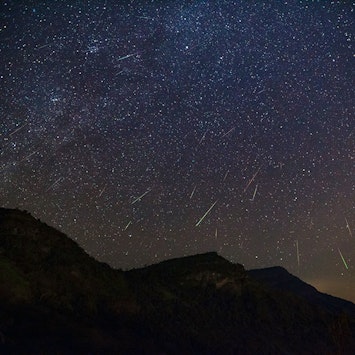Meteor Showers and the Pleiades
Discovery Place Nature

Welcome back to Searching the Sky, Discovery Place's monthly sky watching and astronomy column.
Last month, we discussed some notable constellations and other features of the fall night sky. As we move towards winter, several other special features will start to become visible.
Two of these are the Leonid and Geminid meteor shower. For some background on what a meteor shower is and tips on how to spot meteors, check out our August sky watching blog. The first meteor shower that we will be able to see over the next few months is the Leonid shower, which is thus named because most of the meteors in this shower seem to originate from the area in the sky in which the constellation of Leo the Lion is located.
This year, the Leonid meteor shower will peak and be most visible on Saturday, November 17 through Sunday, November 18. Unfortunately, we will have a waxing gibbous Moon during the peak of the Leonids this year. This means the side of the Moon facing the Earth is more than halfway lit up, which makes it very bright and difficult for us to see meteors in the night sky. To avoid this problem, try going out in the very early morning on November 17 and November 18 after the Moon has appeared to set and before the Sun has appeared to rise.
Even with a dark sky, we can expect to only see about ten to fifteen meteors per hour during the peak of the Leonids. The Geminid meteor shower, which appears to originate from the area of the sky in which the constellation of Gemini the Twins is located, is a much easier meteor shower to observe than the Leonids. Not only do the meteors of the Geminids tend to be very bright, but the Geminids are expected to peak at about one hundred meteors per hour from Thursday, December 13 to Friday, December 14. Like the Leonids and many other meteor showers, the Geminids are best viewed in the early morning before the Sun appears to rise.
Mars will continue to be extremely bright and very visible in the night sky throughout the month of November; for information on why Mars has been much more visible in the night sky over the past few months than it usually is, check out our July sky watching blog. If you don’t own a telescope, you can use a pair of binoculars to look at Mars. While you won’t be able to see features of Mars as if you were using a high powered telescope, Mars may appear to be a more vivid red when viewed through binoculars.
Another great target for binoculars is a group of stars called the Pleiades. Oftentimes, stars that appear to be close to each other in the night sky from our vantage point in Earth are not actually close together out in space. The Pleiades appear to be tightly clustered together in the constellation of Taurus the Bull, and actually, are located near each other in space. The Pleiades are an open star cluster, or a group of stars that formed at around the same time in the same area of space. When viewed with the naked eye, the Pleiades appear to be a group of seven stars right near the “V” of the horns of Taurus. When viewed through binoculars, however, you can see many other stars located in this open star cluster.
Happy star hunting!





